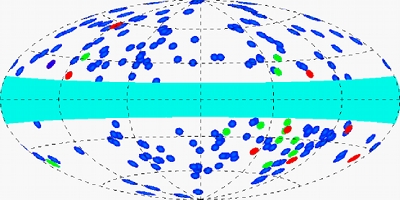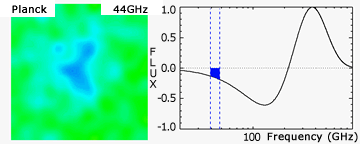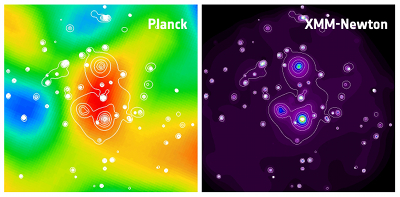Planck's successful hunt probes galaxy clusters on very broad mass range
11 January 2011
The first all-sky survey of galaxy clusters detected via the Sunyaev-Zel'dovich effect is amongst the highlights presented by the Planck Collaboration at a conference held from 10 to 14 January 2011 in Paris, France. The survey, which has benefited from a fruitful collaboration with ESA's XMM-Newton observatory, probes a wide range of cluster masses and other properties, which is unprecedented for a Sunyaev-Zel'dovich sample. Along with the first results enabled by the survey, the Early Sunyaev-Zel'dovich Cluster sample is being publicly released, providing the community with a robust data set for further studies and follow-up observations of galaxy clusters.While mapping the tiny fluctuations in the Cosmic Microwave Background (CMB), which will ultimately expose the early Universe in unprecedented detail, ESA's Planck satellite has been performing the first all-sky survey of galaxy clusters detected with high reliability via the Sunyaev-Zel'dovich effect (SZE). "The survey resulted in the Early Sunyaev-Zel'dovich Cluster sample, a very robust sample of galaxy clusters which is among the first scientific products arising from the Planck mission to be made publicly available," comments Jan Tauber, Planck Project Scientist at ESA.
|
All-sky distribution of all galaxy clusters and cluster candidates reported in the Early Sunyaev-Zel'dovich sample. Credit: ESA/Planck Collaboration |
The SZE is an extremely powerful tool to probe galaxy clusters, the largest gravitationally-bound structures in the Universe which contain, besides galaxies, also large amounts of hot, ionised gas and even larger quantities of dark matter. As the photons of the CMB travel through the hot gas in a galaxy cluster, their interaction with the electrons present in it imprints a distinctive signature on the CMB signal at various frequencies, thus allowing astronomers to spot the presence of the cluster even at high redshifts. With its nine frequency channels, Planck is optimised to hunt, over the entire sky, for these huge structures which conceal a wealth of cosmological information about the evolution of cosmic structure and the expansion of the Universe.
|
Animation showing how the signal from a galaxy cluster, as observed by Planck via the Sunyaev-Zel'dovich effect, varies with different frequencies. Credit: ESA/Planck Collabration |
"Thanks to the excellent data collected by Planck during its first all-sky survey, we have now assembled a unique catalogue of 189 clusters which are spread all over the sky, and span a broad range of masses, up to the highest masses," says Nabila Aghanim of the Institut d'Astrophysique Spatiale in Orsay, France, who coordinates the effort within the Planck Collaboration of identifying the galaxy clusters. The clusters in the early catalogue have masses covering the range 1–15 x 1014 times the mass of the Sun, up to the highest masses and their redshifts vary between 0.01 and 0.55, with the majority of detections corresponding to a redshift of about 0.3. "Among the structures detected by Planck, 169 coincide with already known galaxy clusters and for most of them it is the very first time we measure their SZE signal. This will open new possibilities for multi-frequency studies of clusters. The remaining 20 are brand-new discoveries," she adds. Surveying the whole sky, Planck offers the unique chance of finding the most massive amongst galaxy clusters, which are rare and represent an extremely valuable tool for cosmological studies, as their number is very sensitive to a number of parameters that determine the model used to describe our Universe.
|
Planck and XMM-Newton images of the newly discovered supercluster PLCK G214.6-37.0, composed of three sub-structures and located at a redshift of z~0.45. Credit: ESA/Planck Collaboration |
Observations in X-rays or at other wavelengths can confirm that the newly discovered objects are indeed galaxy clusters and can be used to estimate their redshift. Of the 20 new candidates in the set of 189 pinpointed during Planck's first survey, 11 have already been confirmed thanks to follow-up data gathered by ESA's X-ray observatory, XMM-Newton. Furthermore, an additional batch of ten clusters or super-clusters have also been discovered by Planck and confirmed by XMM-Newton. They will be made public at the same time as the Early Sunyaev-Zel'dovich sample.
"The X-ray data show that most of Planck's new detections are very massive clusters with low luminosity and a disturbed morphology, highlighting that their dynamical state is more complex than that of the galaxy clusters that are customarily detected within X-ray surveys," notes Monique Arnaud from the Service d'Astrophysique, Commissariat à l'Energie Atomique, France, who leads the Planck group following up cluster candidates with XMM-Newton. "The X-ray data revealed that four of the Planck candidates correspond to multiple systems of clusters, including two superclusters consisting of at least three clusters each," she adds.
The excellent data set provided by Planck has also allowed a series of more in-depth studies relying on multi-wavelength observations of galaxy clusters. "By combining the clusters from the Early Sunyaev-Zel'dovich sample with complementary X-ray data from the XMM-Newton archive, we have shown that the properties of clusters, as measured with the SZE, are remarkably consistent with those inferred from X-rays observations," notes Etienne Pointecouteau from the Institut de Recherche en Astrophysique et en Planétologie in Toulouse, France. Another study, following a statistical approach, focussed on seeking the signature, in the Planck maps, of all the previously known X-ray clusters, and has highlighted how the X-ray and SZE views of galaxy clusters are consistent with each other. "The excellent agreement we have found between the actually observed SZE quantities and their predictions based on X-ray data underlines the robustness of our overall empirical view of the properties of the hot ionised gas filling the galaxy clusters," comments Jean-Baptiste Melin from the Service de Physique des Particules, Commissariat à l'Energie Atomique, France. This ensemble of results allows us to answer a long-standing question regarding the consistency between the SZE and X-ray and to show that there are no missing hot baryons.
One of the important results emerging from Planck's first survey is the statistical detection of the SZE signal from very low-mass systems, down to about 5 x 1013 times the mass of the Sun. "While Planck is not sensitive enough to detect individual structures with such a low mass, it has been possible to measure this signal using a statistical approach," says Jim Bartlett from the Laboratoire Astroparticule et Cosmologie in Paris, France, and Jet Propulsion Laboratory, California Institute of Technology, USA. Almost 14,000 clusters were selected from an optical catalogue that spans a wide range in mass and their faint SZ signals were integrated in the Planck data at their known locations: the cumulative signal detected by Planck was then binned according to the cluster richness, which is an estimator of mass. This has allowed Planck scientists to see, for the first time, the SZE signal all the way from low-mass structures, namely groups of galaxies and poor clusters, to the most massive and rich clusters. The measured average signal is less strong than it was expected based on models of massive X-ray clusters: the origin of this discrepancy is intriguing and could have important implications for our understanding of how clusters are detected in optical catalogues.
"In spite of it being only an early product of the mission, the cluster sample released this week has already produced a number of very interesting scientific results," comments Tauber. "We have also learned how difficult it is to find these objects using the SZE, and the Planck teams have done an outstanding job of delivering this Early Sunyaev-Zel'dovich Cluster sample so quickly. The full catalogue, which will be released in early 2013, will most likely contain several hundreds of clusters up to redshift z=1 and will allow an even deeper understanding of the physics of galaxy clusters and of the overall process of cosmic structure formation," he concludes.
Notes for editors
ESA's Planck mission maps the sky in nine frequencies using two state-of-the-art instruments, designed to produce high-sensitivity, multi-frequency measurements of the diffuse sky radiation: the High Frequency Instrument (HFI) includes the frequency bands 100 – 857 GHz, and the Low Frequency Instrument (LFI) includes the frequency bands 30-70 GHz.
The Planck Early Release Compact Source Catalogue (ERCSC), including the Early Sunyaev-Zel'dovich Cluster sample, and the first scientific results to emerge from this mission are being presented this week (10-14 January 2011) at the conference "The Millimeter and Submillimeter Sky in the Planck Mission Era" held in Paris, France.
The ERCSC is based on the scans gathered during Planck's first all-sky survey, between 13 August 2009 and 6 June 2010. Planck will continue to gather data at least until the end of 2011, during which time it will have completed over four all-sky scans.
The initial programme of follow-up observations using XMM-Newton, undertaken in Director's Discretionary Time, has the main goal of confirming the nature of a selected set of cluster candidates detected by Planck via the SZE.
The Planck Scientific Collaboration consists of all the scientists who have contributed to the development of the Planck mission, and who participate in the scientific exploitation of the Planck data during the proprietary period, which nominally ends with the release of the scientific products to the community 3.5 yr after launch, i.e. in January 2013. These scientists are members of one or more of four consortia: the LFI Consortium, the HFI Consortium, the DK-Planck Consortium, and ESA's Planck Science Office.
Related publications
Planck Collaboration 2011, "Planck Early Results: The early SZ cluster sample from Planck", submitted to Astronomy & Astrophysics
Planck Collaboration 2011, "Planck Early Results: XMM-Newton follow-up for validation of Planck discovered clusters", submitted to Astronomy & Astrophysics
Planck Collaboration 2011, "Planck Early Results: Statistical analysis of SZ scaling relations for X-ray galaxy clusters", submitted to Astronomy & Astrophysics
Planck Collaboration 2011, "Planck Early Results: Calibration of the local galaxy cluster SZ scaling relations with the Planck survey", submitted to Astronomy & Astrophysics
Planck Collaboration 2011, "Planck Early Results: Cluster SZ-Optical Scaling Relations", submitted to Astronomy & Astrophysics
Contacts
Nabila Aghanim
Institut d'Astrophysique Spatiale
CNRS – Université Paris Sud
Orsay, France
Email: nabila.aghanim ias.u-psud.fr
ias.u-psud.fr
Phone: +33 1 69 85 86 46
Monique Arnaud
CEA Saclay
Service d'Astrophysique
France
Email: Monique.Arnaud cea.fr
cea.fr
Phone: +33 1 69 08 20 41
Etienne Pointecouteau
Institut de Recherche en Astrophysique et en Planétologie
CNRS - Université de Toulouse
Toulouse, France
Email: Etienne.Pointecouteau cesr.fr
cesr.fr
Phone: +33 (0)5 61 55 81 89
Jean-Baptiste Melin
CEA Saclay
Service de Physique des Particules
France
Email: jean-baptiste.melin cea.fr
cea.fr
Phone: +33 1 69 08 42 64
James Bartlett
Laboratoire Astroparticule et Cosmologie
Paris, France
and
Jet Propulsion Laboratory, California Institute of Technology
Pasadena, USA
Email: bartlett apc.univ-paris7.fr
apc.univ-paris7.fr
Phone: +1-818-636-6175
Jan Tauber
ESA Planck Project Scientist
Directorate of Science & Robotic Exploration
ESA, The Netherlands
Email: jtauber rssd.esa.int
rssd.esa.int
Phone: +31 71 5655342
Norbert Schartel
ESA XMM-Newton Project Scientist
Directorate of Science and Robotic Exploration
ESA, The Netherlands
Email: Norbert.Schartel esa.int
esa.int
Phone: +34 91 8131 184





